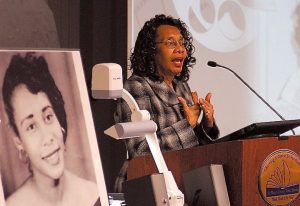Joan Groves Briscoe
First to integrate Great Mills High School in St. Mary’s County, a pioneer for integration in Southern Maryland.
(1941-

Joan Groves (Briscoe) and her younger brother Conrad entered Great Mill’s High School in St. Mary’s County, Maryland under a court order in the fall of 1958. Together they were seeking their civil right to an education. They were the first Black students to attend Great Mill’s High School since it opened its doors in 1927. The St. Mary’s County Public Schools had been segregated since a public education system was established following the Civil War.
In 1957, the Groves family had appealed unsuccessfully to the State Board of Education for admission to Great Mills High Schools. They were successful with their appeal to the U.S. Court of Appeals, Fourth District the following year. Joan spent her final year of high school at Great Mills, 1958-59. She graduated from there in 1959. Her brother transferred to a private religious school after that first year. Very few Black students attended Great Mills until the county ended its dual segregated system in the school year 1966-67.
Joan Groves Briscoe and several former Great Mills High students, faculty, and administrators who experienced the process of desegregation were interviewed in 2004-2007, and the transcripts are accessible. Their stories are shared in a book and a video documentary listed below in the additional resources.
Quotes from the interviews:
“I certainly didn’t want to start any trouble. I’m no flag waver. I just wanted my kids to get a good education and learn to get along among the white people like they’ll have to do in business later.” William Groves, Joan’s father
“. . . what the white people had wanted to happen was for integration to take place slowly. And what they would do is they would start at kindergarten and start working the way up. So you wouldn’t have any black person graduating from a white school for at least twelve years. And in twelve years, by that time, you were finished with it. Your children were grown and they were out of the way. [giggle] Somebody else’s kids could, you know, could deal with it but my parents understood that a whole generation of kids would be lost like that.
Joan Groves Briscoe
“And I was very, very grateful and very thankful to all the teachers that were so kind and all the kids that were kind to me, you know. And the ones that weren’t, I just–I–to this day, I just feel sorry for them, you know. I have to believe that now all that’s gone. I have to believe that, you know, you grow up. After a while, yeah, you grow up. You’re facing everything.”
Joan Groves Briscoe
Additional Resources
Oral history interview with Joan Groves Briscoe: transcript https://smcm.contentdm.oclc.org/digital/collection/p4105coll5/id/386/rec/12
Video: With All Deliberate Speed: One High School’s Story:
Book: In Relentless Pursuit of an Education: African American Stories from a Century of Segregation 1865-1967
